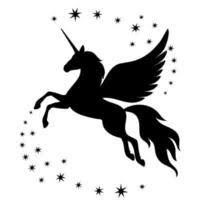Galaxy Season
Added on 09 February 2024
-------------------------------------------------------------------------------------------------------
Galaxy Season
Observing night of February 7th 2024
February and March is 'galaxy season'. These are the months when the constellations of Leo the lion, Coma Berenices, Canes Venatici and Ursa Major are most prominent in the evening skies and it is in these areas where the richest fields of galaxies are to be found. The most dense of these fields is in Coma Berenices; Berenice's hair.
Coma, of course, meaning 'hair', κόμη, which is where we get the word 'comet'. Comets were known as 'broom stars' back in the day because of the 'hairy' tail that emanated from what appeared to be a star. Another example would be the 'comma' that we use in writing as a punctuation mark; (looks just like a little comet) or a comb to straighten your hair.
Coma Berenices lies between the tail of Leo the lion and Bootes the herdsman with Canes Venatici just above and close to the feet of Ursa Major. A line from the star Denebola (which means tail, like Deneb in Cygnus, (Dhanab al-Dajājah in Arabic) and the fiery-red Arcturus underscores the area in which to look, and anywhere above that line there are galaxies in profusion.
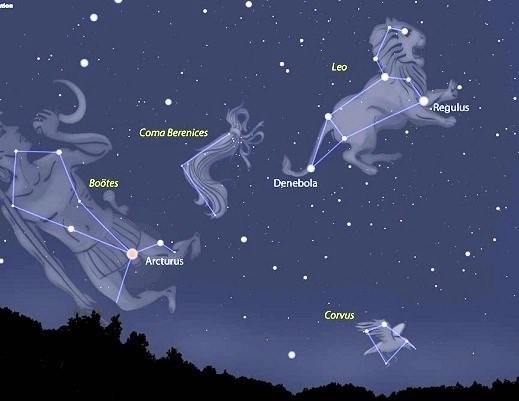
So, February the 7th marked the start of the 'season' with a beautiful, clear and starry night which drew a number of us away from our fire-sides and into the icy darkness of Culloden battlefield to peer into the vast space above in search of these 'island' universes. I say 'island' because up until the 1920s or so, galaxies were called nebulae and were thought to probably reside in the Milky Way. This was the strong belief of Harlow Shapley of Mount Wilson who was of the view that galaxies, ( at the time called 'spiral nebulae' ) were contained in the Milky Way ( which represented the entire universe ) and were made up of gas. This was contested by Heber D Curtis of Lick observatory who maintained that these 'nebulae' were external to the Milky Way and therefore universes in their own right, or 'island' universes.
This argument became known as 'The Great Debate' of 1920, held at a meeting in the Smithsonian National Museum during the Hale lectures of that year.
Well, the rest is 'history' as they say, and we now call them galaxies and that they are as remote in distance, and large in size that no human brain can usefully envisage or comprehend. You can check it out here if you want to know more. https://apod.nasa.gov/htmltest/gifcity/cs_nrc.html (copy & paste, to use this link)
Carl, Paul and I were accompanied by our newest youngstar, Angus, his mum and dad, Rhona and her dear friend Ewart, at least for the early part of the evening anyway, where they got to see some of the more familiar sights like the Orion Nebula and Jupiter. Later, it was left to the three of us to start looking for the galaxies.
Paul had his exquisite six inch refractor telescope, Carl, his eight inch Cassegrain and I had the twelve inch Dobbin with which to search the skies. Both the former had GOTO facilities on their mounts and I had to rely on my 'star-hopping' abilities, which was fine since I am fortunate in having a photographic memory of where the little grey flecks are amongst the vast ocean of stars.
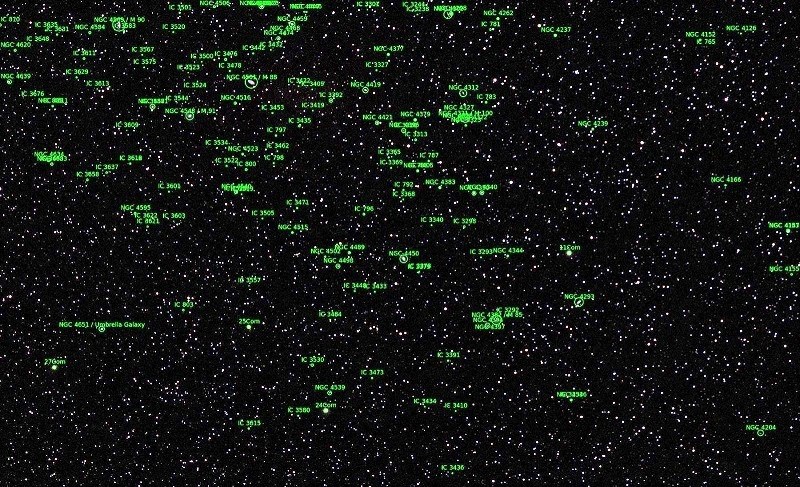
Just some of the galaxies in Coma Berenices. Hard to believe isn't it ? !!!!!
So here is a list of all the galaxies that we saw and then a few details about one or two of them, just to get you in the mood for galaxy hunting.
M51, M108, M109, M100, M101, M102, M64, M49, M98, NGC2244, NGC4565, NGC4490, NGC4395, NGC2976, NGC4494, NGC4725, NGC772, NGC3628, NGC3627, NGC3623, M85, M86, M87, M60, M81, M82, M106.
Let's have a look at NGC3627,28 and 23, AKA the 'Leo triplet'.
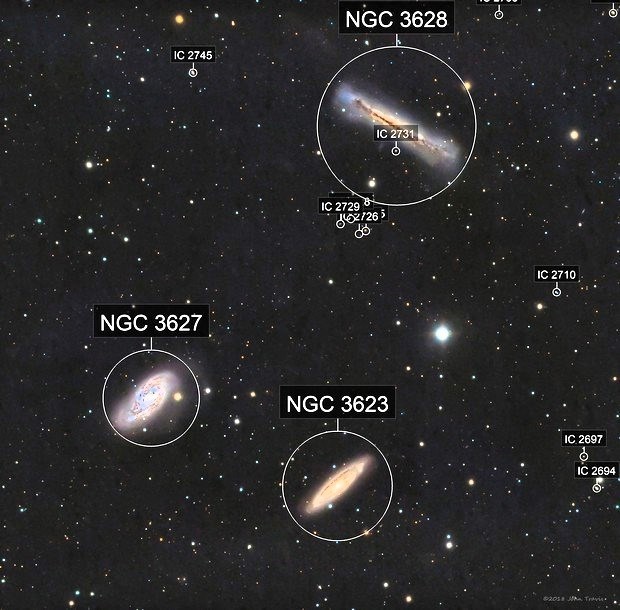
This is a relatively easy group of galaxies to find as they are just under the star Chertan or Theta Leonis in Leo. You will be able to see all three galaxies together in the field of view with a modest telescope of 4 inches or so. They won't look like this photo of course but with the 12 inch at the Observatory the view you get is not far off! The one at the top (NGC 3628) is nicknamed the 'hamburger galaxy' and you can see why! A truly magical sight.
Or how about the Needle galaxy, NGC 4565 in Coma Berenices. You are going to need Paul's 6 inch refractor or the 12 inch Dobbin for this one and even then it is faint; but that said, the needle, edge-on shape is quite clear and it is one to savour for many minutes at the eyepiece. Even the dark line that bisects it is visible! It hangs like a tiny silver shard in the blackness of its surroundings and has a mesmeric effect that draws you back to look again and again.
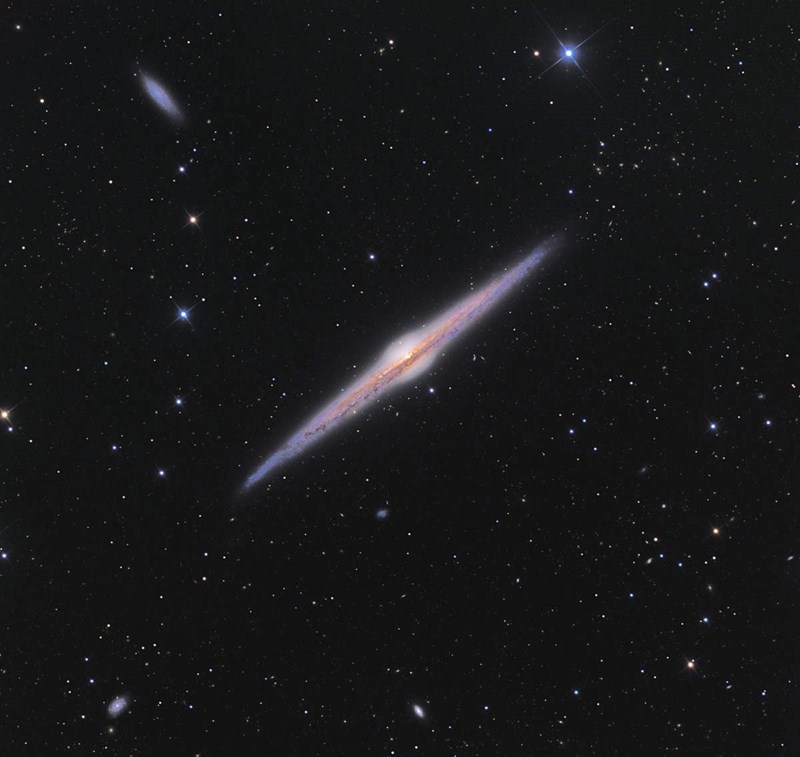
This last one, for now, is M109 in Ursa Major. It sits right next to Phecda, the bottom left star in the square of the 'Plough' asterism and to see it clearly it is best to move the star out of the field of view as it will flood the galaxy with light making it more difficult to see. Not the star in the photo by the way; Phecda is off to one side and much brighter. It is another faint one but we have to think that Messier himself saw it, doubtless with inferior equipment than you can lay hands on and it's on the Messier challenge list. Best to see it with the large apertures available at the Observatory though and don't even think about finding it from an urban area or if the Moon is riding high in the sky.
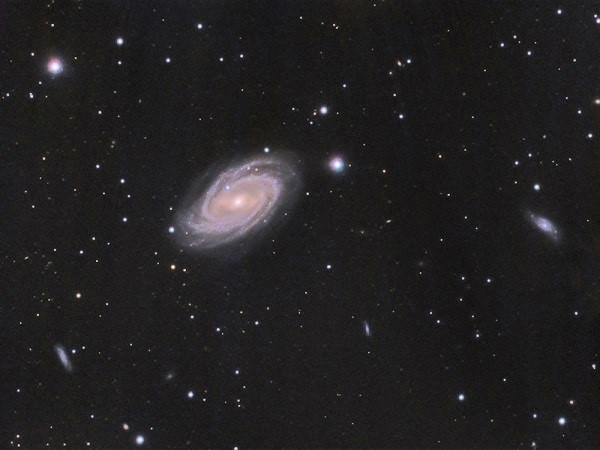
Obviously, these images are not what you will see with a telescope, but it is our intention in the coming weeks to arrange a night of astrophotography where it will be possible, with long exposure shots taken with 'sky-trackers' at the Observatory, to see details closely matching the ones seen here. So keep a lookout on the Club media for information about that. Here are a couple of examples with just a DSLR.
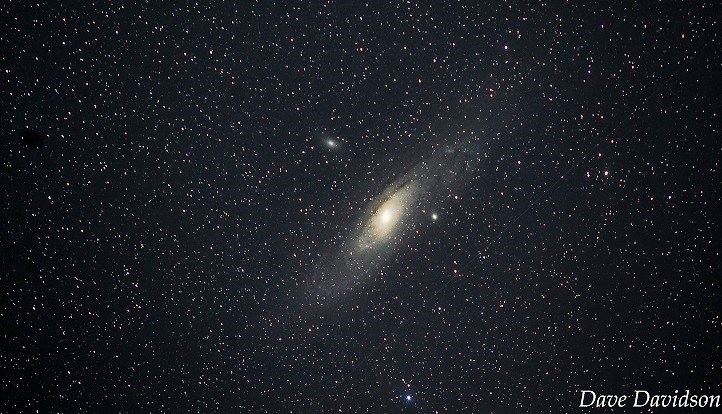
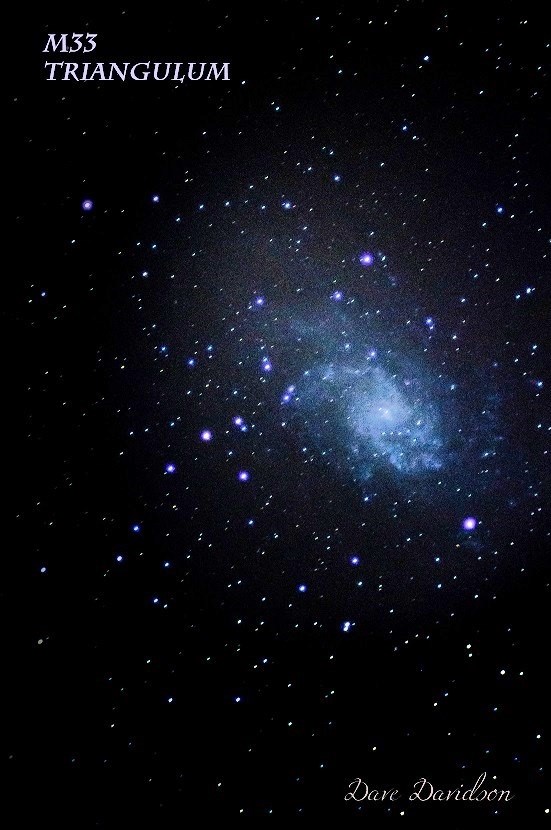
Despite the deep cold of -5 degC, we continued looking at galaxies until after 10 o'clock; the time simply passing unnoticed as we were so absorbed in what we were doing. The clarity of the sky was just incredible and the stars blazed out of the darkness with startling brilliance. The firmament above traced out with the bold patterns of the constellations. Orion, due south at 10 o'clock, now leaning right to reveal beneath his feet, the great dog Canis Major and the faint fragment of the 'Puppis'; part of a huge constellation from the southern hemisphere leading down to the star Canopus. 'Puppis', the latin translation of 'poop-deck', was originally part of an over-large constellation called 'Argo Navis' which, centuries after its initial description, was divided into three parts, the other two being Carina and Vela, the keel and the sail of the ship respectively.
Leaping up from behind the big tree, Leo the lion! Vast in size; spanning a full 30 degrees across the sky from Denebola to Regulus, or nose to tail. Ursa Major, looking up to the zenith with the hunting dogs of Canes Venatici snapping at her heels. Such wonders of the night sky.
Though fortified against the February night as we were with winter woolies, like a rising damp, the frost eventually won out and the capillary action of the bitter cold crept up from the ground and we had to concede that our time at the Observatory was at an end for now. It was with great reluctance that we (Carl especially) packed up our gear and got ready for home. Had it not been that Carl needed to be up early for work, I think he might have soldiered on alone!
As always, at the end of these outings, we took a moment to breathe in the majesty of our surroundings. It is a moment of almost ontological shock when you look up and realise the immensity and the symmetry of what you are standing beneath. Hardly anyone can not be touched with the wonder and awe that it inspires.
So, if you think that you would like to see for yourself, then please join us on one of the (hopefully) starry nights to come, in what remains of February and into March. WhatsApp, Facebook and the website https://www.spacegazer.com will alert you to when we will be back again at the Observatory.
Dark skies forever.
